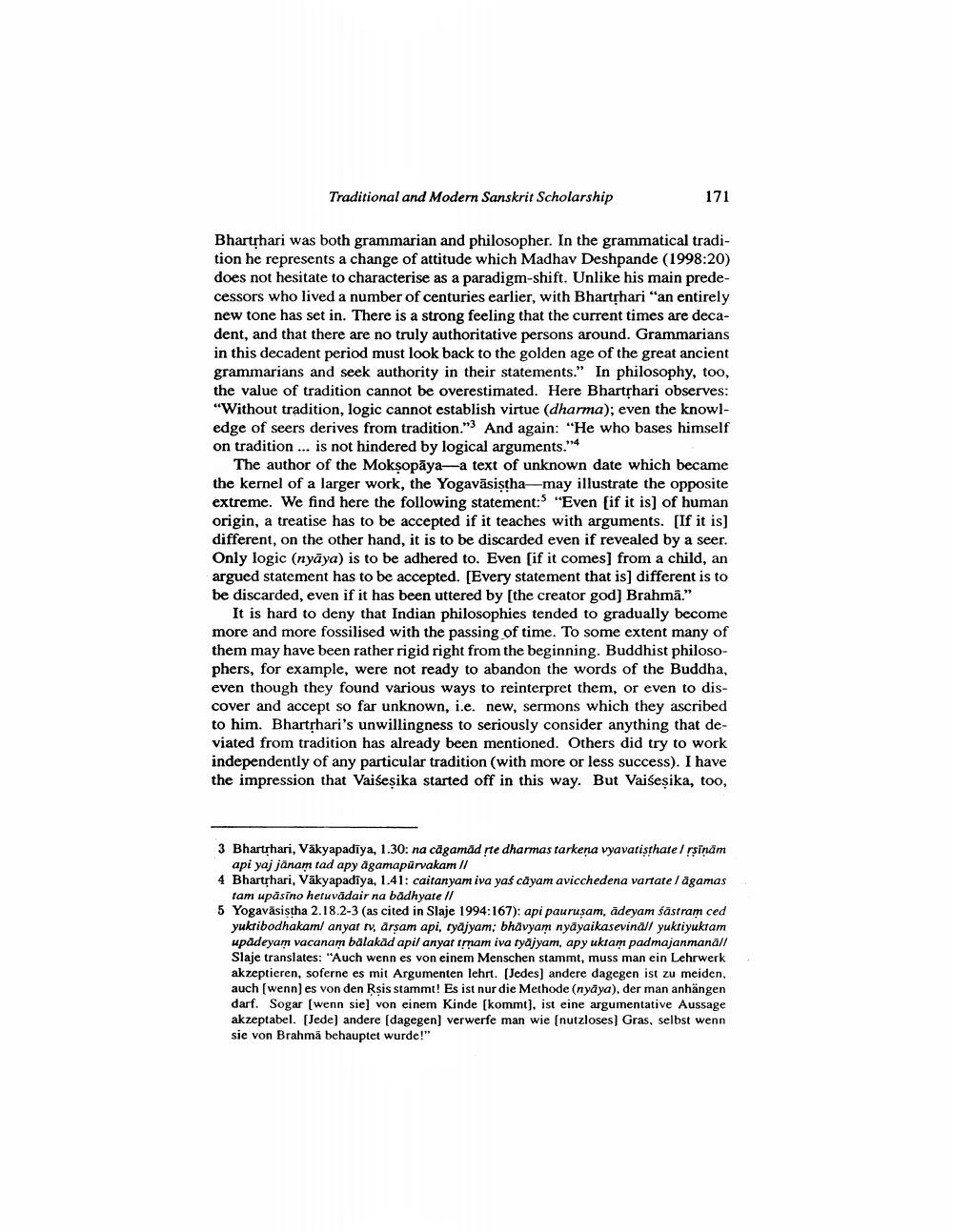________________
Traditional and Modern Sanskrit Scholarship
171
Bharthari was both grammarian and philosopher. In the grammatical tradition he represents a change of attitude which Madhav Deshpande (1998:20) does not hesitate to characterise as a paradigm-shift. Unlike his main predecessors who lived a number of centuries earlier, with Bharthari "an entirely new tone has set in. There is a strong feeling that the current times are decadent, and that there are no truly authoritative persons around. Grammarians in this decadent period must look back to the golden age of the great ancient grammarians and seek authority in their statements." In philosophy, too, the value of tradition cannot be overestimated. Here Bharthari observes: "Without tradition, logic cannot establish virtue (dharma); even the knowledge of seers derives from tradition."3 And again: "He who bases himself on tradition ... is not hindered by logical arguments."
The author of the Moksopāya-a text of unknown date which became the kernel of a larger work, the Yogavāsistha—may illustrate the opposite extreme. We find here the following statement: "Even if it is of human origin, a treatise has to be accepted if it teaches with arguments. [If it is] different, on the other hand, it is to be discarded even if revealed by a seer. Only logic (nyāya) is to be adhered to. Even if it comes] from a child, an argued statement has to be accepted. (Every statement that is] different is to be discarded, even if it has been uttered by [the creator god) Brahma."
It is hard to deny that Indian philosophies tended to gradually become more and more fossilised with the passing of time. To some extent many of them may have been rather rigid right from the beginning. Buddhist philosophers, for example, were not ready to abandon the words of the Buddha, even though they found various ways to reinterpret them, or even to discover and accept so far unknown, i.e. new, sermons which they ascribed to him. Bhartshari's unwillingness to seriously consider anything that deviated from tradition has already been mentioned. Others did try to work independently of any particular tradition (with more or less success). I have the impression that Vaisesika started off in this way. But Vaiśesika, too,
3 Bharthari, Väkyapadiya, 1.30: na căgamad te dharmas tarkena vyavatisthatel rsīnām
api yaj janam tad apy agamapūrvakam // 4 Bharthari, Vākyapadiya, 1.41: caitanyam iva yas cāyam avicchedena vartate lāgamas
tam upāsīno hetuvādair na badhyate II 5 Yogavāsistha 2.18.2-3 (as cited in Slaje 1994:167): api paurusam, ādeyam śāstram ced
yuktibodhakam/ anyat tv, arsam api, tyäjyam; bhavyam nyayaikasevināll yukriyuktam upādeyam vacanam bālakad apil anyar imam iva tyājyam, apy ukram padmajanmanā// Slaje translates: "Auch wenn es von einem Menschen stammt, muss man ein Lehrwerk akzeptieren, soferne es mit Argumenten lehrt. (Jedes) andere dagegen ist zu meiden, auch wenn es von den Rsis stammt! Es ist nur die Methode (nyaya), der man anhängen darf. Sogar (wenn sie) von einem Kinde [kommt), ist eine argumentative Aussage akzeptabel. (Jede) andere (dagegen) verwerfe man wie (nutzloses) Gras, selbst wenn sie von Brahmā behauptet wurde!"




